Glastonbury Visit: Stonehenge and Avebury
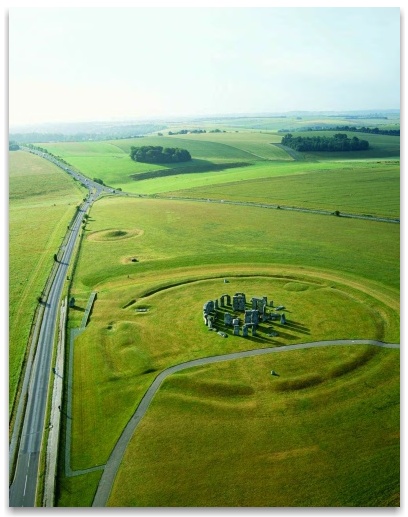
Photo of Stonehenge World Heritage Site
– covers 2,600 hectares (6,500 acres) of chalk lowland
and arable fields in Wiltshire
John and I traveled to Stonehenge and Avebury in Wiltshire, U.K. They were made World Heritage Sites in 1986 for the outstanding prehistoric monuments from the Neolithic and Bronze Age periods.
Stonehenge (3000-1600BC) is the most famous and sophisticated stone circle in the world, aligned on the solstice sunrise and sunset. Ancient and mysterious, Stonehenge is also an amazing feat of prehistoric engineering.
Looking at Stonehenge from the road, John thought they had to be extraterrestrial – meaning there was no way the ancient peoples of the land could have moved those huge stones 25 miles across Salisbury Plains from where they were quarried in ancient days, to 330 ft. above sea level.”
He said, ” It must have been the same thing with those huge stone figures on Easter Island – where they came from only God knows.”
Alcheringa Speaks:
(Information given by Alcheringa is shown in different colour.)
Valerie: I asked Alcheringa about the beginnings of Stonehenge. The stones were said to be placed in 3000 BC or even 10,000 BC Could you advise when they were placed?
Alcheringa: The original stones were placed before Atlantis fell – in other words they are over 12,000 years old. However the smaller stones were added later by the Druid Priests. We as the Blue People taught the people of the time to understand ceremonies connected to Astronomy and Astrology and did our best to help them to understand that influence upon the Earth.
As I have said, the site itself has changed since we first introduced it to the little Earthling – however, unfortunately, there were ceremonies that began later and sacrifices were made. This was not the intention, it is not what we were teaching in the first place.
From the starpeople’s point of view, the huge stones were very easily lifted by levitation and very easily placed in a circle. There has been movement in the earth since the Stone circles were first erected and some fell down; but as I have said over hundreds and thousands of years there has been additions made to them. However it’s first role was to align with the Sun, the Solstice in the Summer and the Solstice winter sun alignment.
(For more about the Summer Solstice at Stonehenge, you may read a National Geographic article … See also National Geographic on the Winter Solstice )
Alcheringa: This was, and is, the best time for the ceremonies to take place and to lift the energies by the prayers that were made at that time, and still do, to align to the centre of the earth.
Valerie: Thank you. Is there anything else I can say? I am having problems taking the article somewhere!
Alcheringa: You can quote me My Dear. … You can suggest that people do their own research about Stonehenge and Avebury.
I would remind you that there are many, many crop circles created in that area – it is no co-incidence. The area is a point of Light upon this earth as are other points of Light upon this earth such as the Pyramids in Egypt and Uluru in the centre of Australia. There are others as well. These points of energy are uplifting and the consciousness of the people can be uplifted if they are open to change. This is all you need to say, My Dear.
Valerie: Oh. O.K. Thank you. There is talk about the Druids; but what about the Celts can they be seen in the ancient times and the Deities … (I was thinking of Isis, and Osiris from Egypt)
Alcheringa: It is the same My Dear. The Deities are the starpeople. And they did influence the people and this is exactly what I am saying to you, the focus was upon the Sun in your so-called pagan ceremonies.
Valerie: Why yes, the focus is upon the sun … of course. Thank you – thank you.
Alcheringa: It is My pleasure My Dear.
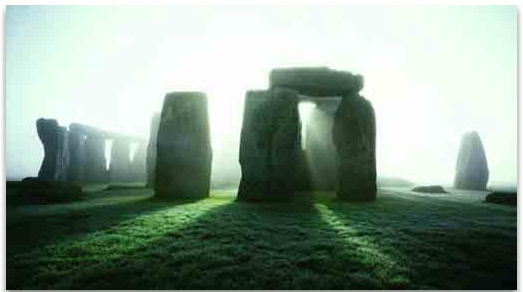
Stonehenge at Sunrise
When John and I arrived at Stonehenge there were hundreds of tourists waiting to walk under the road to reach the site – we were not allowed to walk closely to the huge stones – however we noticed a flock of birds alight on to one of the lintels just as we arrived and when it was time for us to leave, they flew away. We felt it was a ‘sign’ from Holy Spirit – letting us know they were with us.
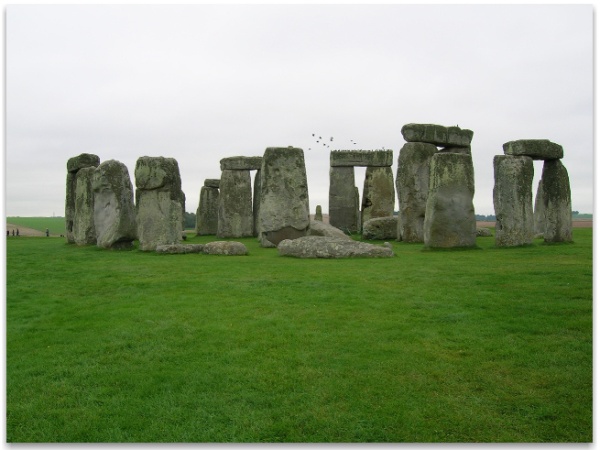
A flock of birds arrives at Stonehenge
I had visited the site as a young woman in 1953 and was disappointed to find I could no longer walk inside the circle and touch the huge stones. All the time I was hoping for a sign from Holy Spirit but except for the birds all landing on one particular lintel – there was nothing.
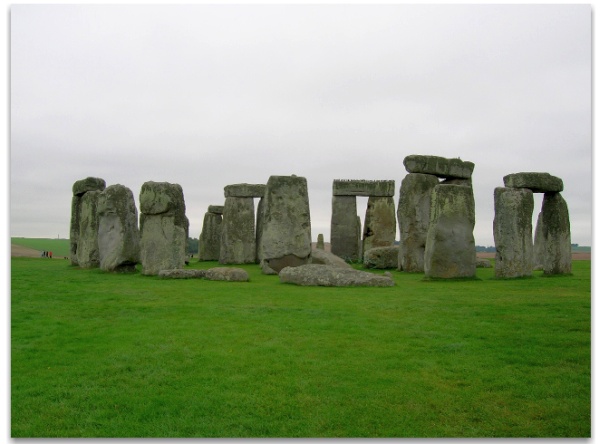
The flock of birds are visible atop a plinth at Stonehenge
To be honest John and I felt that there was something missing and it could have been all the people moving about without a ceremony taking place … to honour the ancient sacred site. This saddened us.
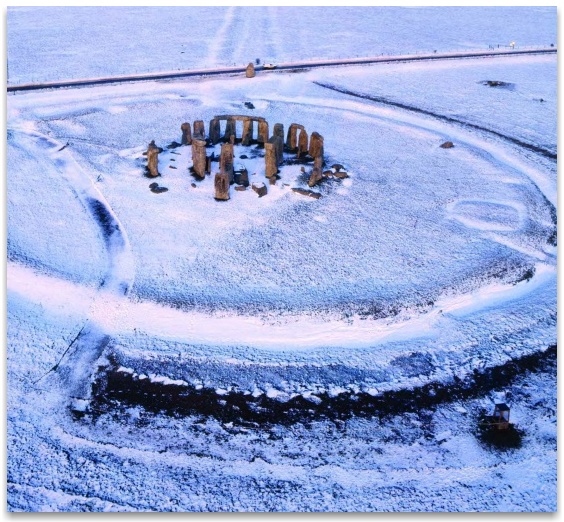
Stonehenge in the Snow
Another insight was given to the existence of Chalk or limestone in a large area of Southern England and also northern France which shows an ancient link to the two places being once together before major techtonic plate shifts.
We enjoyed traveling around the countryside of Wiltshire, an ancient land, steeped in myth and legend. Sun was filtering through large green leafy trees overhanging narrow stone walled roads. We passed several White Horses cut into the depth of chalk on the green hills high above us, although we didn’t make the long trek to walk to all of them.
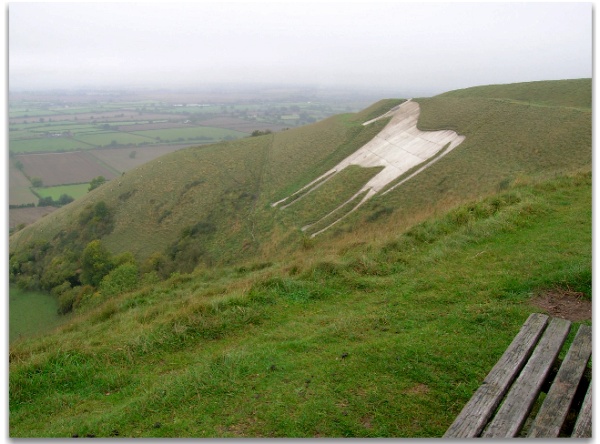
One of the White Horses in the chalk hills of Wiltshire, UK
I hadn’t really given much thought to White horses until I read the following website:
“Wiltshire is the county for white horses. There are or were at least twenty-four of these hill figures in Britain, with no less than thirteen being in Wiltshire, and another white horse, the oldest of them all, being just over the border in Oxfordshire. Most of the white horses are chalk hill carvings, and the chalk downs of central Wiltshire make it an ideal place for such figures.
Of the thirteen white horses known to have existed in Wiltshire, eight are still visible, and the others have either been lost completely, or are in a sense still there, under the turf, but have long since become grown over and are no longer visible.
Contrary to popular belief, most white horses are not of great antiquity. Only the Uffington white horse is of certain prehistoric origin, being some three thousand years old. Most of the others date from the last three hundred years or so, though the hillside white horse can be a slippery creature, and the origins of some are impossible to establish with any certainty.
“The following website concentrates on the Wiltshire horses, but aims to include all known hillside white horses in Britain and elsewhere, and includes some which are not chalk hill carvings but have been created by other methods. It does not cover hill figures other than white horses.” See Wiltshire White Horses
What is the interest in the White Horse?
‘White Horse’ is one of the most popular horse related key-phrases used on the net. The Overture Database recorded 15,261 enquiries in December in the English speaking world alone. Why?. What’s so special about White Horse?
The answer is that the White Horse has a totally different significance or importance to different members and different religions of the human race. All the different interests combined add up to a formidable total. And, yet there is one common theme running through every interest: religion, or more precisely spirituality, an obsession with the enduring truths of our very existence, our significance as human-beings and the iconography that accompanies this.
The principal interests in White Horse are as follows:-
- The White Horse was a religious symbol to the Celts and to the Romans. There is enormous fascination in the Druids, Stonehenge, the Celtic religion, and the origin of the Chalk Downland sculptures in Britain and elsewhere. Epona and her White Horse has acquired cult status today among those seeking after the eternal verities. Jewellers create Epona charms and necklaces
- Jesus rode on a White Horse, the scriptures refer to a White Horse in the Horsemen of the Apocalypse, and it was a White Horse Saint George rode in the Crusades. The White Horse acquired a huge iconic significance to Christians. The Crusaders rode White Horses whenever possible, and legend has it they amassed armies with white flags and white horses. Martin Luther’s admirers met at the White Horse Inn at Cambridge at the beginning of the Reformation, the iconography crossing the Atlantic with the Pilgrim Fathers and embedding itself within the US .
- White Horses became symbols of power. Conquerors and army generals adopted White Horses as their mounts.
- Breeding White Horses for War Horses became fashionable. White Horses became status symbols.
- White Horses were bred for their beauty, their symbolic value and their value as mounts.
- White Horses became popular subjects for famous painters, like Gaugin and Constable.
White Horses from Spain and the Camargue form the bedrock of out breeding stock for the white horses we enjoy owning and riding for pleasure today.” Citation from: Hints and Things
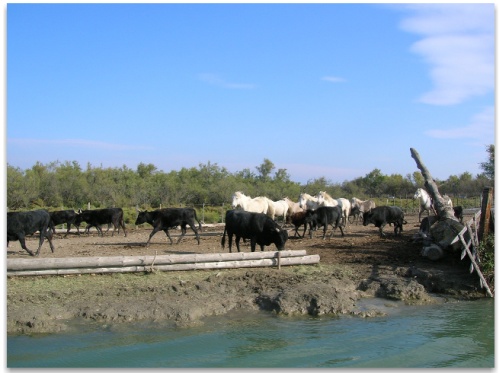
White horses in the herd at the Camargue – Les Saintes Maries de la Mer
Well isn’t that interesting – we saw the white horses at the Camargue on the night of the Evocation … when we saw where Jesus’ family first landed in South of France after escaping from Egypt.
The symbol of the white horse was obviously known 5,000 years ago in Briton – I cannot help but remember the time when I was first awakened by a ‘Voice’ from an unseen being. Later, when wondering who the Being may be, I suddenly saw in my innerscene a beautiful white horse with wings – my immediate thought was ‘Pegasus.’
At another time when meditating on Sai Baba, I saw, in my inner scene, a bearded man in white robes ride up to me straddled on a beautiful white horse and hand me a large scroll. Not long after that I was given the material for the Book “Alcheringa and the first ancestors.”
John said, “Napoleon owned a lot of white horses – the most famous was Marengo. He wouldn’t go into battle without it and there is a belief he lost the battle of Waterloo because he was on foot and not mounted.”

Napoleon on his White Horse
What! With that story about people having past life memories of being star people and the ancestors of the earth human, is it not a co-ordinated incidence that there are so many ‘crop circles’ becoming more complicated each year and our awareness of the existence of star people who we know are creating the crop circles?
Please have a look at some of these crop circles, many of them appear in the Southern part of England, particularly in Wiltshire near where these Sacred sites are.
Link for Crop Circles in Wiltshire, UK, 2010
Link for crop circles – rest of the world

Avebury, Wiltshire, was our next destination – The area is so large it is easier to see the Stone Circles from aerial photographs. It is a centre of an enormous amount of crop circle activity.
Click here for many Avebury Stone Circle photos:
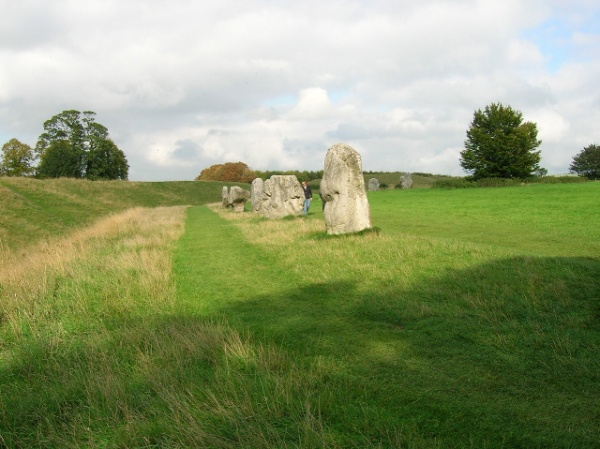
Ditch and stones, Avebury, UK.
Avebury is the site of an ancient monument consisting of a large henge, several stone circles, stone avenues and barrows (burial mounds), surrounding the village of Avebury in the English county of Wiltshire. It is one of the finest and largest Neolithic monuments in Europe, about 5,000 years old. Although older than the megalithic stones of Stonehenge 32 kilometres to the south, the two monuments are broadly contemporary overall.
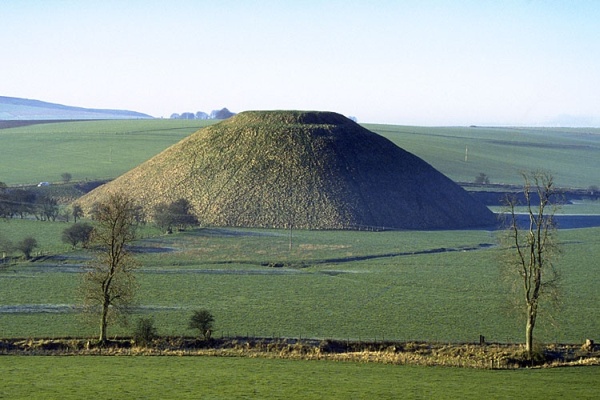
5,000 year old Silbury is the largest prehistoric man-made hill in Europe.
Silbury Hill is an artificial chalk mound near Avebury in the English county of Wiltshire. It is part of the Stonehenge, Avebury and Associated Sites UNESCO World Heritage Site.
At 37 metres (120 ft) high, Silbury Hill – which is part of the complex of Neolithic monuments around Avebury, which includes the Avebury Ring and West Kennet Long Barrow. Silbury Hill is the tallest prehistoric human-made mound in Europe and one of the largest in the world; it is similar in size to some of the smaller Egyptian pyramids of the Giza Necropolis.
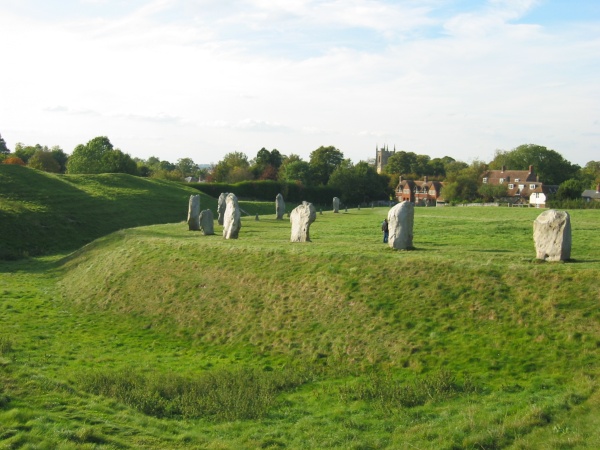
Ditch and stone circle, Avebury, UK.
Started over 5,000 years ago this great Henge encloses an area of about 27 acres. Using only the tools of the time, deer antlers as picks and cattle shoulder blades as shovels, the builders dug and moved 120,000 cubic metres of material This was an immense undertaking by any measure, taking bout 1,500,000 man hours.
In the centre of the huge stone circle is a pub with much activity, noise and drinking. John was extremely upset and critical of them. Did not like the energy at all – when we tuned in we found that he had been a Priest in ancient times and that was why he was so upset with everybody’s behaviour – people were not honouring the centre of the very large stone circle.
I placed my hands on one of the huge stones – a Guardian – and felt that the stones had been, after movement in the earth, replaced incorrectly in some places and that again the Blue People had placed them, like Stonehenge, in the first place before Atlantis fell.
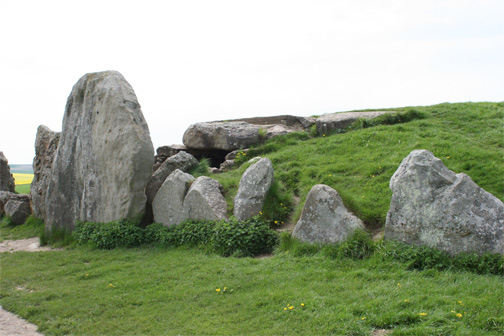
West Kennet Long Barrow
The largest long barrow in England of 107 metres length stands on a hill above the River Kennet. Dug from two ditches ten metres either side about 5,000 years ago it encloses five stone-lined chambers made from sarsen boulders. It was used as a ritual burial place for many centuries before being closed and sealed by huge stones.

Entrance to the burial chambers, West Kennet Long Barrow
The next article is about the mysterious Rennes Le Chateau and the Val de Dieu. (Valley of God in South of France)
